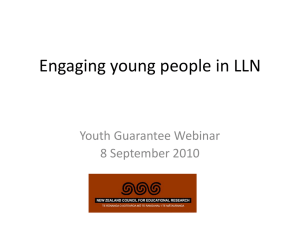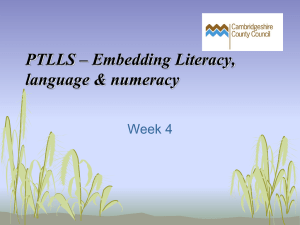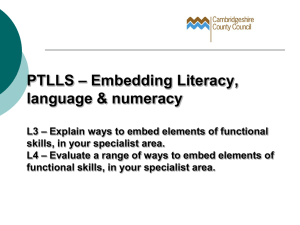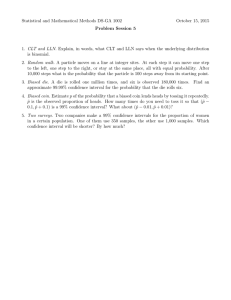Identify clients with language, literacy and
advertisement
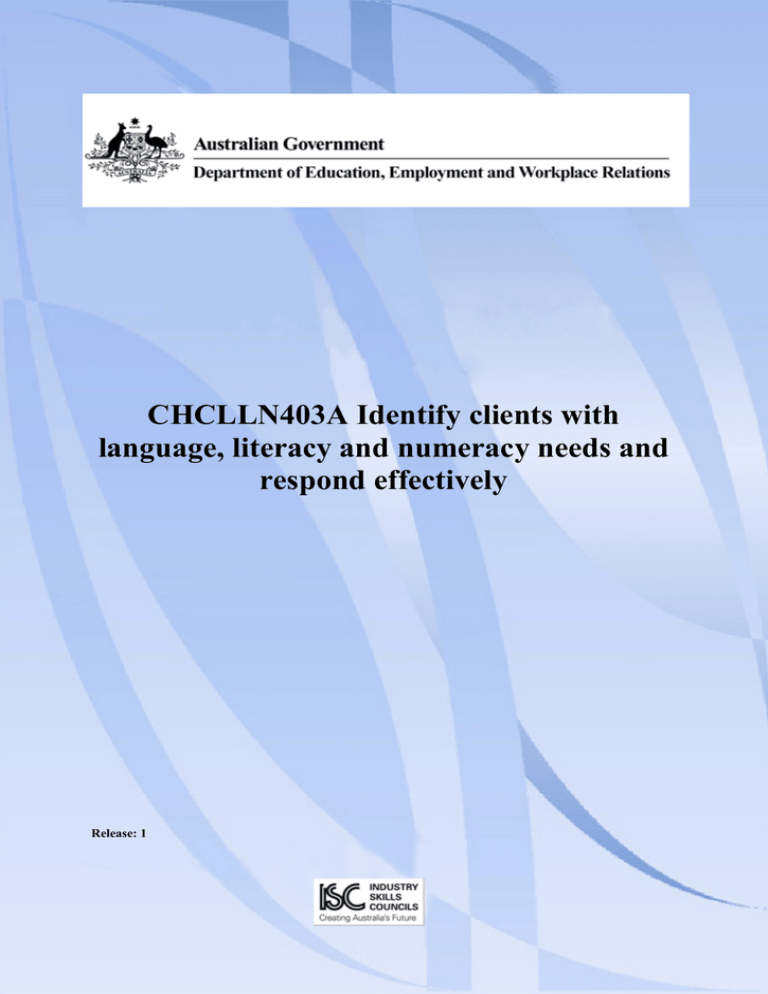
CHCLLN403A Identify clients with language, literacy and numeracy needs and respond effectively Release: 1 CHCLLN403A Identify clients with language, literacy and numeracy needs and respond effectively Date this document was generated: 5 October 2012 CHCLLN403A Identify clients with language, literacy and numeracy needs and respond effectively Modification History Not Applicable Unit Descriptor Descriptor This unit describes the skills and knowledge required to identify when clients' language, literacy and numeracy (LLN) are impeding their access to the service being provided, to adjust service delivery where required to accommodate client LLN skills, and to refer appropriately in order to improve client outcomes The unit does not provide workers with the skills and knowledge to identify LLN skill levels or to actively intervene in developing a client's LLN skills Application of the Unit Application This unit of competency applies to workers from a range of backgrounds who support clients with LLN needs It may apply to workers carrying out individual client assessments and managing caseloads as part of their work role Workers undertaking this unit do not require specialist LLN skills or knowledge Licensing/Regulatory Information Not Applicable Pre-Requisites Not Applicable Approved © Commonwealth of Australia, 2012 Page 2 of 11 Community Services and Health Industry Skills Council CHCLLN403A Identify clients with language, literacy and numeracy needs and respond effectively Date this document was generated: 5 October 2012 Employability Skills Information Employability Skills This unit contains Employability Skills Elements and Performance Criteria Pre-Content Elements define the essential outcomes of a unit of competency. The Performance Criteria specify the level of performance required to demonstrate achievement of the Element. Terms in italics are elaborated in the Range Statement. Elements and Performance Criteria ELEMENT PERFORMANCE CRITERIA 1. Establish if there are LLN 1.1 Identify indicators of LLN needs needs affecting client's access 1.2 Apply knowledge of the context to identify to service inherent LLN requirements 1.3 Establish rapport and identify where client LLN needs may impact on access to service 1.4 Determine the degree to which other issues may impact on the client 2. Determine appropriate strategies to address client's LLN needs Approved © Commonwealth of Australia, 2012 2.1 Determine workable strategies to ensure service delivery meets client LLN needs, including appropriate tools and communication strategies 2.2 Collaborate with client to identify possible areas of LLN need and how to meet client needs 2.3 Prioritise areas for immediate and, where appropriate, longer-term action Page 3 of 11 Community Services and Health Industry Skills Council CHCLLN403A Identify clients with language, literacy and numeracy needs and respond effectively Date this document was generated: 5 October 2012 ELEMENT PERFORMANCE CRITERIA 3. Implement strategies to address agreed LLN needs 3.1 Offer relevant information to client regarding most appropriate support, to enable client to make informed decisions 3.2 Record agreed LLN needs and the strategies used, and report in line with client and organisation requirements 3.3 Monitor client and provide ongoing support and encouragement where appropriate Approved © Commonwealth of Australia, 2012 Page 4 of 11 Community Services and Health Industry Skills Council CHCLLN403A Identify clients with language, literacy and numeracy needs and respond effectively Date this document was generated: 5 October 2012 Required Skills and Knowledge REQUIRED SKILLS AND KNOWLEDGE This describes the essential skills and knowledge and their level required for this unit. Essential knowledge: The candidate must be able to demonstrate essential knowledge required to effectively do the task outlined in elements and performance criteria of this unit, manage the task and manage contingencies in the context of the identified work role These include knowledge and understanding of: Awareness of cultural diversity and protocols to inform service delivery around LLN Communication techniques Indicators of LLN needs, and methods for clarifying them with client Methods for identifying the impact of other service-related issues on client LLN needs Available LLN information and referral or support services for a range of LLN needs and clients Recording and reporting requirements Essential skills: It is critical that the candidate demonstrate the ability to: Identify LLN demands of the service being accessed Identify clients' LLN needs impacting on their ability to effectively access services Provide information to clients on current, available and appropriate LLN support services and information to enable clients to make informed decisions Collaborate with clients to determine most appropriate support for LLN needs Maintain accurate and sufficient records of strategies and outcomes. continued ... Essential skills (contd): In addition, the candidate must be able to effectively do the task outlined in elements and performance criteria of this unit, manage the task and manage contingencies in the context of the identified work role These include: Client-management skills to: deal with complex needs and sometimes difficult or challenging behaviour Approved © Commonwealth of Australia, 2012 Page 5 of 11 Community Services and Health Industry Skills Council CHCLLN403A Identify clients with language, literacy and numeracy needs and respond effectively Date this document was generated: 5 October 2012 REQUIRED SKILLS AND KNOWLEDGE discuss appropriate support for client LLN needs operate within duty of care and organisational requirements to address client LLN needs Communication skills to: collaborate productively with client listen actively to client and identify indicators of LLN needs Initiative and enterprise skills to: accommodate client's LLN needs impacting on effective access to service access or refer client to appropriate support to improve client's access to service ensure that current and correct information regarding LLN support services is readily available to client raise awareness, share knowledge and help client to think about making changes to improve LLN where appropriate Interpersonal skills to: establish rapport with client interact with clients from a range of social, cultural, religious and linguistic backgrounds and with varying physical and mental abilities apply cultural and religious protocols to ensure that work practices promote safety Literacy skills to maintain accurate and accessible records of service outcomes Problem-solving skills to collaborate with client to determine most appropriate support for LLN needs Technology skills to use a range of alternative communication tools where appropriate Approved © Commonwealth of Australia, 2012 Page 6 of 11 Community Services and Health Industry Skills Council CHCLLN403A Identify clients with language, literacy and numeracy needs and respond effectively Date this document was generated: 5 October 2012 REQUIRED SKILLS AND KNOWLEDGE Evidence Guide EVIDENCE GUIDE The evidence guide provides advice on assessment and must be read in conjunction with the Performance Criteria, Required Skills and Knowledge, the Range Statement and the Assessment Guidelines for this Training Package. Critical aspects for assessment and evidence required to demonstrate this unit of competency: Access and equity considerations: Context of and specific resources for assessment: Approved © Commonwealth of Australia, 2012 The individual being assessed must provide evidence of specified essential knowledge as well as skills Assessment should ensure the candidate addresses the elements and performance criteria on at least three occasions, over a period of time All workers in community services should be aware of access, equity and human rights issues in relation to their own area of work All workers should develop their ability to work in a culturally diverse environment In recognition of particular issues facing Aboriginal and Torres Strait Islander communities, workers should be aware of cultural, historical and current issues impacting on Aboriginal and Torres Strait Islander people Assessors and trainers must take into account relevant access and equity issues, in particular relating to factors impacting on Aboriginal and/or Torres Strait Islander clients and communities Competency must be demonstrated in a realistic simulated or real work environment Assessment must ensure access to opportunities to work with clients with a range of LLN needs Page 7 of 11 Community Services and Health Industry Skills Council CHCLLN403A Identify clients with language, literacy and numeracy needs and respond effectively Date this document was generated: 5 October 2012 EVIDENCE GUIDE Method of assessment: Guidance information Approved © Commonwealth of Australia, 2012 Assessment methods suitable for valid and reliable assessment of this competency may include a combination of: case studies demonstration observation oral and written questioning scenarios, simulation or role plays authenticated evidence Assessment methods should reflect work demands, such as literacy, and the needs of particular individuals, such as: people in rural and remote locations people with disabilities people from culturally and linguistically diverse backgrounds Aboriginal and Torres Strait Islander people women young people older people This unit may be assessed independently, however holistic assessment with other units relevant to the industry sector, workplace and job role is recommended Page 8 of 11 Community Services and Health Industry Skills Council CHCLLN403A Identify clients with language, literacy and numeracy needs and respond effectively Date this document was generated: 5 October 2012 Range Statement RANGE STATEMENT The Range Statement relates to the unit of competency as a whole. It allows for different work environments and situations that may affect performance. Add any essential operating conditions that may be present with training and assessment depending on the work situation, needs of the candidate, accessibility of the item, and local industry and regional contexts. Indicators of LLN needs may include: LLN needs: Approved © Commonwealth of Australia, 2012 Cultural factors, such as: ethnicity language background Disabilities, such as acquired brain injury Employment history Health issues, including chronic conditions Personal factors, such as: Aboriginal or Torres Strait Islander background displacement issues for refugees isolation, including geographic remoteness and personal isolation low-level or interrupted formal education trauma-related issues Behavioural, such as: strategies used to avoid revealing an LLN issue becoming agitated or angry Relate to: a range of learning, reading, writing, oral communication and numeracy skills impact of LLN issue on client Will depend on a complex mix of factors, including: client's presenting needs service provision context Page 9 of 11 Community Services and Health Industry Skills Council CHCLLN403A Identify clients with language, literacy and numeracy needs and respond effectively Date this document was generated: 5 October 2012 RANGE STATEMENT Client may include: Presenting person seeking to access a service and their: parent, sibling or spouse legal guardian carer, such as disability carer case worker Other issues may include: Those related to service, such as: high LLN demand inherent in service Those related to client, such as: alcohol and other drugs cultural factors disability, including reading or learning disability health, including: chronic conditions mental health homelessness unemployment Workable strategies may include those that: Approved © Commonwealth of Australia, 2012 Are consistent with: client's cultural and sociocultural protocols client's needs and preferences own skills and available support Build on strengths of client Maintain the integrity of the relationship with client Provide opportunities to discuss and review Page 10 of 11 Community Services and Health Industry Skills Council CHCLLN403A Identify clients with language, literacy and numeracy needs and respond effectively Date this document was generated: 5 October 2012 RANGE STATEMENT Tools may include: Information may include: Augmentative and alternative communication, including: aided and unaided strategies, including access techniques assistive technology, such as closed captioning, subtitling and teleprompting software visual aids, such as photographs, maps, diagrams and symbols Dictionaries Support person Interpreter, including: language other than English Auslan and Makaton Alternative ways of accessing required information Relevant and current LLN information available in own organisation Referral to support services, such as: assistive technology in-house support services interpreter or translator specialist assistance community learning centres and other not-forprofit organisations tutor support programs, such as the home tutor scheme Service-specific information and strategies, such as templates, for use with such things as complex forms Mentoring support Unit Sector(s) Not Applicable Approved © Commonwealth of Australia, 2012 Page 11 of 11 Community Services and Health Industry Skills Council
